The Langerhans cell histiocytosis management market is estimated to be valued at USD 656.5 million in 2025 and is projected to reach USD 1209.4 million by 2035, registering a compound annual growth rate (CAGR) of 6.3% over the forecast period.
Pediatric hematologist-oncologists evaluate treatment protocols based on disease extent classification, organ system involvement patterns, and patient age considerations when establishing management strategies for single-system lesions, multisystem disease presentations, and CNS-risk categories. Therapeutic selection involves analyzing chemotherapy regimen effectiveness, targeted therapy mechanisms, and supportive care requirements while considering long-term sequelae risks, fertility preservation needs, and quality of life maintenance necessary for optimal patient outcomes throughout extended treatment periods. Treatment decisions balance therapeutic intensity against toxicity profiles, considering growth and development impact, secondary malignancy risks, and psychosocial adjustment factors that influence comprehensive care planning.
Clinical management requires specialized diagnostic capabilities, treatment monitoring systems, and multidisciplinary coordination that ensure accurate disease assessment while maintaining treatment response evaluation throughout varying disease presentations and therapeutic approaches. Care delivery involves managing biopsy coordination, imaging surveillance, and laboratory monitoring while addressing family education, psychological support, and care coordination across multiple specialists including dermatology, endocrinology, and neurosurgery. Protocol adherence encompasses dosing modifications, toxicity management, and response assessment that maintain treatment efficacy while minimizing adverse effects throughout complex therapeutic regimens.
Interdisciplinary coordination involves pediatric oncologists, pathologists, and specialized nurses collaborating to optimize treatment delivery that balances disease control with developmental considerations while addressing specific patient characteristics and disease behavior patterns. Care protocols encompass diagnostic confirmation procedures, staging evaluation, and treatment response monitoring while coordinating with radiology services, surgical specialties, and rehabilitation teams. Support systems address family counseling, educational accommodation, and long-term follow-up planning essential for comprehensive patient care and optimal developmental outcomes throughout treatment and survivorship periods.
Therapeutic advancement prioritizes targeted therapy development, immunomodulatory approaches, and precision medicine applications that address specific molecular abnormalities while reducing treatment-related toxicity throughout langerhans cell histiocytosis management. Research initiatives include BRAF inhibitor investigation, immune checkpoint modulator exploration, and combination therapy evaluation that expand treatment options while improving response rates and reducing long-term complications. Innovation encompasses biomarker-guided therapy, minimal residual disease monitoring, and personalized treatment approaches that optimize therapeutic effectiveness while minimizing unnecessary treatment exposure.
Treatment specialization addresses low-risk disease requiring minimal intervention approaches, high-risk presentations needing intensive multiagent therapy, and refractory cases demanding salvage treatment strategies that leverage specialized expertise for diverse disease manifestations. Healthcare providers coordinate with research institutions, patient advocacy organizations, and international cooperative groups to establish comprehensive treatment programs that address rare disease challenges while maintaining access to innovative therapies and clinical trials. Specialized services encompass neurodegenerative complications management, endocrine dysfunction treatment, and long-term surveillance programs that require multisystem expertise and coordinated care delivery.
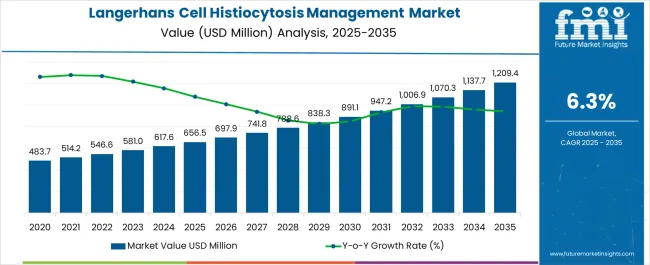
| Metric | Value |
|---|---|
| Langerhans Cell Histiocytosis Management Market Estimated Value in (2025 E) | USD 656.5 million |
| Langerhans Cell Histiocytosis Management Market Forecast Value in (2035 F) | USD 1209.4 million |
| Forecast CAGR (2025 to 2035) | 6.3% |
The Langerhans cell histiocytosis management market is expanding steadily as advancements in immunotherapy and biologics redefine treatment protocols for rare diseases. Increased clinical research activity and the development of targeted therapies are driving adoption across healthcare systems.
Rising awareness among healthcare providers and patient advocacy groups has further supported early diagnosis and treatment initiation. The growing inclusion of biologics in clinical guidelines reflects a shift toward precision medicine, improving outcomes and reducing relapse risks.
Regulatory approvals and orphan drug designations are also accelerating market availability of novel therapies. As healthcare systems prioritize rare disease management and specialized oncology care, the outlook for this market remains positive with continuous innovation and stronger patient support frameworks reinforcing growth.
The market is segmented by Drug Class, Distribution Channel, and End User and region. By Drug Class, the market is divided into Emapalumab, Alemtuzumab, and Infiximab. In terms of Distribution Channel, the market is classified into Hospital Pharmacy, Retail Pharmacy, and Online Pharmacy. Based on End User, the market is segmented into Hospitals and Specialty Clinics. Regionally, the market is classified into North America, Latin America, Western Europe, Eastern Europe, Balkan & Baltic Countries, Russia & Belarus, Central Asia, East Asia, South Asia & Pacific, and the Middle East & Africa.
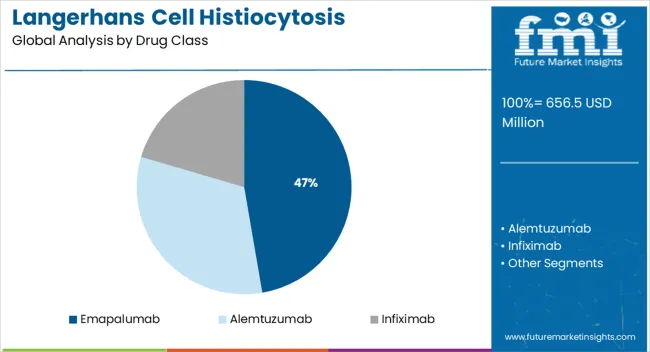
The emapalumab segment is expected to represent 47.30% of total market revenue by 2025 within the drug class category, making it the dominant segment. Growth has been supported by its targeted mechanism of action, addressing the immune dysregulation associated with histiocytic disorders.
Its demonstrated efficacy in improving patient outcomes and reducing severe inflammatory complications has reinforced its clinical adoption. Strong regulatory support and orphan designation incentives have further accelerated the availability of emapalumab in treatment pathways.
The focus on therapies with high efficacy in rare disease management has positioned emapalumab as the preferred choice within this category.
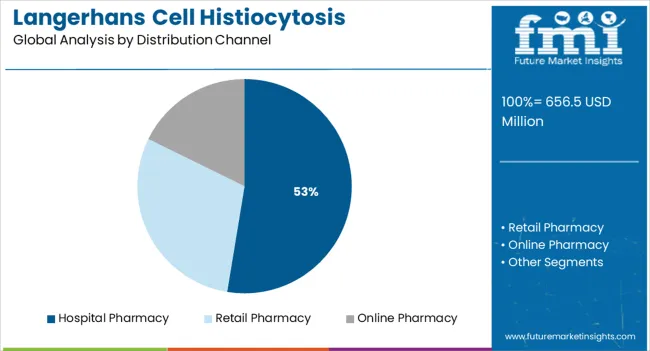
The hospital pharmacy segment is projected to account for 52.60% of total market revenue by 2025 within the distribution channel category. Its leadership is attributed to the controlled distribution of biologics and immunotherapies that require specialized handling, administration, and monitoring.
Hospital pharmacies have been integral in ensuring secure supply chains, compliance with treatment protocols, and access to novel therapeutics under strict supervision.
The rise in inpatient care and the critical role of hospitals in rare disease management have further consolidated this segment’s position as the leading distribution channel.
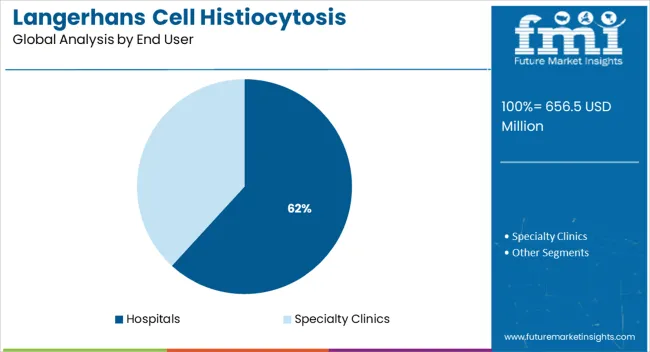
The hospitals segment is anticipated to hold 61.80% of overall revenue by 2025 within the end user category, emerging as the largest segment. This dominance is driven by the availability of advanced infrastructure, multidisciplinary care teams, and access to specialized treatments required for managing complex histiocytic disorders.
Hospitals also serve as referral centers for rare disease patients, facilitating early diagnosis, coordinated care, and clinical trial participation.
With rising emphasis on comprehensive oncology and rare disease care, hospitals remain the cornerstone end user segment, ensuring patient access to advanced therapies and holistic treatment pathways.
According to market research and competitive intelligence provider Future Market Insights- the market for Langerhans cell histiocytosis management reflected a value of 4.1% during the historical period, 2020 to 2025.
It is widely recognized that the market for LCH management has been growing in recent years due to a combination of factors, including the increasing incidence of LCH, advances in treatment, and growing investment in research and development.
Additionally, the COVID-19 pandemic has had an impact on the market, leading to disruptions in the supply chain and reductions in healthcare spending in some countries. However, it has also led to an increased focus on the development of new and more effective treatments for LCH, which is likely to drive growth in the market in the coming years.
Thus, the market for Langerhans cell histiocytosis management is expected to register a CAGR of 6.3% in the forecast period 2025 to 2035.
Increasing prevalence of Langerhans cell histiocytosis spurring growth of the market
The number of cases of LCH is increasing, particularly in developed countries, due to the improved diagnosis and reporting of the condition. In addition, there is a growing awareness of LCH among healthcare professionals and the general population, leading to earlier diagnosis and treatment of the condition.
The development of new and effective treatments for LCH, including chemotherapy, radiotherapy, and immunotherapy, is driving the growth of the market. Moreover, the expansion of healthcare infrastructure in developing countries is making it easier for patients to access treatment and improve their chances of recovery.
Governments in many countries are providing financial support for the research and development of new treatments for LCH, which is bolstering the growth of the market. Furthermore, the increasing investment in research and development by pharmaceutical companies is leading to the development of new and more effective treatments for LCH, driving the growth of the market.
Availability of treatments favoring the growth of Langerhans cell histiocytosis management market
Langerhans Cell Histiocytosis (LCH) is a rare condition that affects the skin, bones, and other organs. The treatment options for LCH vary depending on the severity and extent of the disease, as well as the age and overall health of the patient. Some of the treatments available for LCH include:
Chemotherapy: Chemotherapy is a common treatment for LCH. It involves the use of drugs to kill the abnormal cells that are causing the condition. Chemotherapy may be given orally, intravenously, or topically, depending on the severity of the disease.
Corticosteroids: Corticosteroids are drugs that help to reduce inflammation and swelling. They may be used to manage symptoms of LCH, especially in mild cases.
Radiotherapy: Radiotherapy is a treatment that uses high-energy radiation to kill abnormal cells. It may be used to treat localized LCH, especially in bones and joints.
Surgery: In some cases, surgery may be necessary to remove tumors or other growths caused by LCH.
Stem cell transplant: In severe cases of LCH, a stem cell transplant may be used to replace the patient's abnormal cells with healthy ones.
Other treatments: Other treatments for LCH may include immunotherapy, biologic therapy, and targeted therapy.
Difficulty in diagnosing along with expensive nature of treatment affecting market growth for Langerhans cell histiocytosis management market
There is still limited understanding of the underlying causes of LCH, which can make it difficult to develop effective treatments for the condition. The cost of treating LCH is high, particularly for patients in developing countries where access to healthcare is limited.
In addition, LCH can be difficult to diagnose in its early stages, leading to delayed treatment and poorer outcomes for patients. The treatments available for LCH can have serious side effects, including nausea, vomiting, hair loss, and fatigue, which can impact the quality of life of patients. Furthermore, access to treatment for LCH can be limited in developing countries, where healthcare infrastructure may not be fully developed.
There is intense competition in the LCH management market, with a large number of pharmaceutical companies vying for a share of the market. This can make it difficult for new entrants to gain a foothold in the market. All these factors are affecting the growth of the LCH management market.
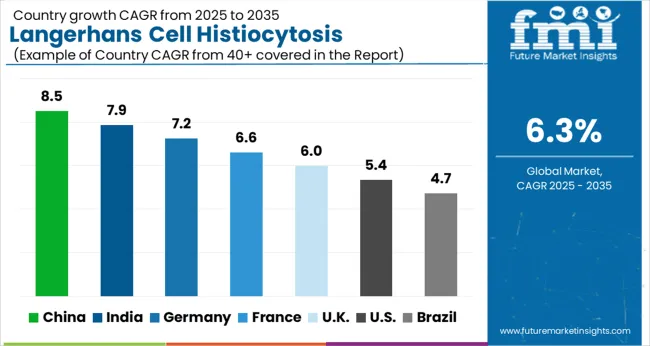
Investment in research and development creating lucrative opportunities for LCH management market
The North American market for Langerhans Cell Histiocytosis (LCH) management is a significant market for the treatment and management of this condition. The United States is the largest market for LCH management in North America, due to a combination of factors, including a high incidence of LCH, advanced healthcare infrastructure, and a high level of investment in research and development.
In recent years, there has been a growing awareness of LCH in North America, leading to earlier diagnosis and treatment of the condition. This, combined with advances in treatment and growing investment in research and development, has driven growth in the North American LCH management market. Thus, North America is expected to possess 40% market share for LCH management market in 2025.
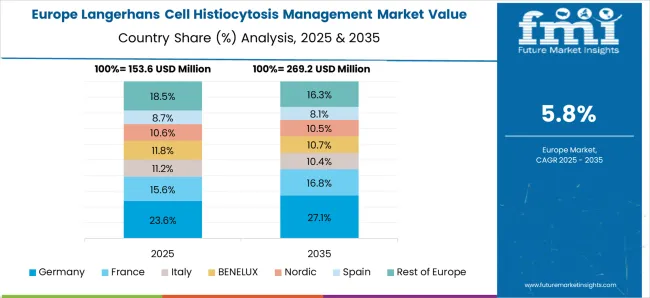
Government policies and healthcare spending creating lucrative opportunities for LCH management market
The European market for Langerhans Cell Histiocytosis (LCH) management is a significant market for the treatment and management of this condition. Europe is home to a large and growing population of LCH patients, making it an important market for the development and commercialization of new and effective treatments for LCH.
Overall, the European market for LCH management is expected to continue to grow in the coming years, driven by the increasing incidence of LCH, advances in treatment, and growing investment in research and development. However, the exact size and growth of the market will depend on a number of factors, including the progression of the COVID-19 pandemic, government policies, and healthcare spending. Thus, Europe is expected to hold 35% market share for LCH management market in 2025.
Presence of medicines making management of LCH accessible for patients
Hospital pharmacies are often located within or near hospitals, making it easier and more convenient for patients to access their medications. Hospital pharmacists are trained healthcare professionals who have expertise in the treatment and management of LCH. They can provide patients with important information about their medications and help them manage any side effects or adverse reactions.
Hospital pharmacies have strict quality control procedures in place to ensure that patients receive safe, effective, and high-quality medications. Hospital pharmacies have access to specialized medications that may not be available at retail pharmacies. This can be especially important for patients with LCH, as they may need specialized medications to manage their condition.
Hospital pharmacies are often integrated with the medical care that patients receive at the hospital, allowing for better coordination of care and improved outcomes. Thus, hospital pharmacies are expected to possess 46% market share for LCH management market in 2025.
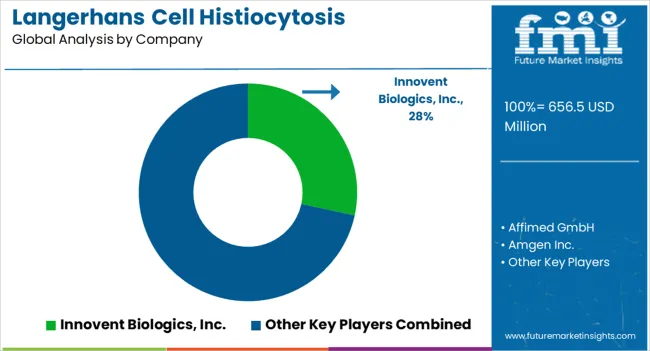
The Langerhans cell histiocytosis (LCH) management market is evolving as biopharmaceutical companies intensify research into targeted immunotherapies and biologics addressing this rare hematologic disorder. Amgen Inc., Sanofi S.A., and F. Hoffmann-La Roche Ltd. lead the field through the development of monoclonal antibodies and targeted inhibitors designed to regulate abnormal dendritic cell proliferation and mitigate multisystemic inflammation. Their clinical programs focus on improving survival rates and minimizing treatment-related toxicities.
AstraZeneca plc and Eli Lilly and Company are expanding their oncology and rare disease pipelines with immunomodulatory drugs that address LCH’s underlying immune dysfunction. Regeneron Pharmaceuticals Inc. and Xencor Inc. are pioneering bispecific antibody platforms that enhance T-cell engagement for selective targeting of diseased cells, improving efficacy while reducing systemic side effects.
Innovent Biologics Inc. and Affimed GmbH are leveraging immuno-oncology expertise to explore next-generation biologics that restore immune balance and inhibit Langerhans cell activation. Pieris Pharmaceuticals Inc. and Mereo BioPharma Group plc contribute through antibody fragment and protein-based therapies designed for rare hematological conditions. TG Therapeutics Inc. focuses on B-cell modulation and signaling pathway inhibitors, offering potential combination approaches for LCH management. The competitive landscape is defined by strong innovation in precision immunotherapy and collaborative clinical research.
| Report Attribute | Details |
|---|---|
| Market Value in 2025 | USD 656.5 million |
| Market Value in 2035 | USD 1209.4 million |
| Growth Rate | CAGR of 6.3% from 2025 to 2035 |
| Base Year for Estimation | 2025 |
| Historical Data | 2020 to 2025 |
| Forecast Period | 2025 to 2035 |
| Quantitative Units | Revenue in USD Million and CAGR from 2025 to 2035 |
| Report Coverage | Revenue Forecast, Volume Forecast, Company Ranking, Competitive Landscape, Growth Factors, Trends and Pricing Analysis |
| Segments Covered | Drug Class, Distribution Channel, End Users, Region |
| Regions Covered | North America; Latin America; Europe; South Asia; East Asia; Oceania; MEA |
| Key Countries Profiled | USA, Canada, Brazil, Argentina, Germany, UK, France, Spain, Italy, Nordics, BENELUX, Australia & New Zealand, China, India, ASEAN, GCC, South Africa |
| Key Companies Profiled |
Innovent Biologics Inc., Affimed GmbH, Amgen Inc., AstraZeneca plc, Sanofi S.A., F. Hoffmann-La Roche Ltd., Regeneron Pharmaceuticals Inc., Eli Lilly and Company, Xencor Inc., Pieris Pharmaceuticals Inc., Mereo BioPharma Group plc, TG Therapeutics Inc. |
| Customization | Available Upon Request |
The global langerhans cell histiocytosis management market is estimated to be valued at USD 656.5 million in 2025.
The market size for the langerhans cell histiocytosis management market is projected to reach USD 1,209.4 million by 2035.
The langerhans cell histiocytosis management market is expected to grow at a 6.3% CAGR between 2025 and 2035.
The key product types in langerhans cell histiocytosis management market are emapalumab, alemtuzumab and infiximab.
In terms of distribution channel, hospital pharmacy segment to command 52.6% share in the langerhans cell histiocytosis management market in 2025.






Our Research Products

The "Full Research Suite" delivers actionable market intel, deep dives on markets or technologies, so clients act faster, cut risk, and unlock growth.

The Leaderboard benchmarks and ranks top vendors, classifying them as Established Leaders, Leading Challengers, or Disruptors & Challengers.

Locates where complements amplify value and substitutes erode it, forecasting net impact by horizon

We deliver granular, decision-grade intel: market sizing, 5-year forecasts, pricing, adoption, usage, revenue, and operational KPIs—plus competitor tracking, regulation, and value chains—across 60 countries broadly.

Spot the shifts before they hit your P&L. We track inflection points, adoption curves, pricing moves, and ecosystem plays to show where demand is heading, why it is changing, and what to do next across high-growth markets and disruptive tech

Real-time reads of user behavior. We track shifting priorities, perceptions of today’s and next-gen services, and provider experience, then pace how fast tech moves from trial to adoption, blending buyer, consumer, and channel inputs with social signals (#WhySwitch, #UX).

Partner with our analyst team to build a custom report designed around your business priorities. From analysing market trends to assessing competitors or crafting bespoke datasets, we tailor insights to your needs.
Supplier Intelligence
Discovery & Profiling
Capacity & Footprint
Performance & Risk
Compliance & Governance
Commercial Readiness
Who Supplies Whom
Scorecards & Shortlists
Playbooks & Docs
Category Intelligence
Definition & Scope
Demand & Use Cases
Cost Drivers
Market Structure
Supply Chain Map
Trade & Policy
Operating Norms
Deliverables
Buyer Intelligence
Account Basics
Spend & Scope
Procurement Model
Vendor Requirements
Terms & Policies
Entry Strategy
Pain Points & Triggers
Outputs
Pricing Analysis
Benchmarks
Trends
Should-Cost
Indexation
Landed Cost
Commercial Terms
Deliverables
Brand Analysis
Positioning & Value Prop
Share & Presence
Customer Evidence
Go-to-Market
Digital & Reputation
Compliance & Trust
KPIs & Gaps
Outputs
Full Research Suite comprises of:
Market outlook & trends analysis
Interviews & case studies
Strategic recommendations
Vendor profiles & capabilities analysis
5-year forecasts
8 regions and 60+ country-level data splits
Market segment data splits
12 months of continuous data updates
DELIVERED AS:
PDF EXCEL ONLINE
Cellulitis Management Market Analysis by Procedure Type, Cellulite Type, End User, and Region: Forecast for 2025 to 2035
Cellulose Diacetate Film Market Size and Share Forecast Outlook 2025 to 2035
Cellulose Fiber Market Forecast and Outlook 2025 to 2035
Cellulite Treatment Market Size and Share Forecast Outlook 2025 to 2035
Cellulose Derivative Market Size and Share Forecast Outlook 2025 to 2035
Cellulose Film Packaging Market Size and Share Forecast Outlook 2025 to 2035
Cell Therapy Systems Market Size and Share Forecast Outlook 2025 to 2035
Cellular IoT Market Size and Share Forecast Outlook 2025 to 2035
Cell Isolation Market Size and Share Forecast Outlook 2025 to 2035
Cellulose Ether and Derivatives Market Size and Share Forecast Outlook 2025 to 2035
Cellular Push-to-talk Market Size and Share Forecast Outlook 2025 to 2035
Cell Culture Waste Aspirator Market Size and Share Forecast Outlook 2025 to 2035
Cell Culture Media Market Size and Share Forecast Outlook 2025 to 2035
Cellulosic Polymers Market Size and Share Forecast Outlook 2025 to 2035
Cellbag Bioreactor Chambers Market Size and Share Forecast Outlook 2025 to 2035
Cell Surface Markers Detection Market Size and Share Forecast Outlook 2025 to 2035
Cellular Modem Market Size and Share Forecast Outlook 2025 to 2035
Cellulite Reduction Treatments Market Size and Share Forecast Outlook 2025 to 2035
Cell Culture Supplements Market Size and Share Forecast Outlook 2025 to 2035
Cell Culture Media & Cell Lines Market Size and Share Forecast Outlook 2025 to 2035

Thank you!
You will receive an email from our Business Development Manager. Please be sure to check your SPAM/JUNK folder too.
Chat With
MaRIA